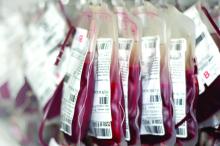Clinical case
A 48-year-old man with cirrhosis and esophageal varices presents to the emergency department with hematochezia and hematemesis. Upon arrival to the floor, he has another bout of hematochezia and hematemesis. He appears pale. His pulse is 90 beats per minute, his blood pressure is 100/60 mmHg, and his respiratory rate is 14 breaths per minute. A complete blood count reveals a hemoglobin level of 7.8 g/dL and hematocrit of 23.5%. Should he receive a blood transfusion?
Introduction
Anemia is one of the most frequent conditions in hospitalized patients. Anemia is variably associated with morbidity and mortality depending on chronicity, etiology, and associated comorbidities. Before the 1980s, standard practice was to transfuse all patients to a hemoglobin level greater than 10 g/dL and/or a hematocrit greater than 30%. However, with concerns about the potential adverse effects and cost of transfusions, the safety and effectiveness of liberal versus restrictive transfusion thresholds became the subject of many studies.
Risks of red blood cell (RBC) transfusions include transmission of bloodborne pathogens and, more commonly, immunological reactions and other noninfectious complications. Modern screening methods for HIV, hepatitis B, and hepatitis C infections in developed countries have markedly reduced the incidence of transfusion-related diseases due to these pathogens, such that in the United States the risk of transfusion-related HIV, hepatitis B, or hepatitis C infections is extremely rare (nearly 1 in a million units or less).1,2 In contrast, noninfectious complications such as febrile transfusion reactions, transfusion associated circulatory overload, and allergic reactions are much more common.1
The 2016 the AABB (formerly American Association of Blood Banks) guidelines focused on the evidence for hemodynamically stable and asymptomatic hospitalized patients. The guidelines are based on randomized controlled trials that measured mortality as the primary endpoint. Most trials and guidelines reinforce that if a patient is symptomatic or hemodynamically unstable from anemia or hemorrhage, RBC transfusion is appropriate irrespective of hemoglobin level.
Overview of the data
Critically ill patients
The Transfusion Requirements in Critical Care (TRICC) trial, published in 1999, was the first large clinical trial examining the safety of restrictive transfusion thresholds in critically ill patients.3
The TRICC trial randomized 838 euvolemic critically ill patients with anemia to a restrictive transfusion strategy (transfusing for hemoglobin less than 7 g/dL) or a liberal strategy (transfusing for hemoglobin less than 10 g/dL). Thirty-day mortality was not significantly different between the two groups, though in prespecified subgroups of less acutely ill patients (APACHE-II score 20 or lower) and younger patients (age less than 55 years), mortality was significantly lower in the restrictive transfusion group. Overall in-hospital mortality was also lower in the restrictive strategy arm.
The subsequent Transfusion Requirements in Septic Shock (TRISS) study involved patients with septic shock and similarly found that patients assigned to a restrictive strategy (transfusion for hemoglobin less than 7 g/dL) had similar outcomes to patients assigned to a liberal strategy (transfusion for hemoglobin less than 9 g/dL). The patients in the restrictive group received fewer transfusions, but had similar rates of 90-day mortality, use of life support, and number of days alive and out of the hospital.4
These large randomized controlled trials in critically ill patients served as the basis for subsequent studies in patient populations outside of the ICU.
Acute upper GI bleed
Acute upper gastrointestinal bleeding (UGIB) is one of the most common indications for RBC transfusion.
A 2013 single-center study randomized patients with and without cirrhosis who presented with evidence of UGIB, such as hematemesis, melena, or bloody nasogastric aspirate, to either a restrictive or liberal transfusion strategy, with hemoglobin transfusion thresholds of less than 7 g/dL and less than 9 g/dL, respectively. All patients received 1 unit of RBCs before assessing baseline hemoglobin level, and all patients underwent upper endoscopy within 6 hours. Patients in the restrictive-strategy group had significantly lower mortality at 45 days, compared with the liberal-strategy group. This finding persisted in a subgroup of patients with Childs-Pugh class A or B cirrhosis, but not Childs-Pugh class C.5
The TRIGGER trial, a cluster randomized multicenter study published in 2015, also found no difference in clinical outcomes, including mortality, between a restrictive strategy and liberal strategy for transfusion of patients with UGIB.6
Perioperative patients
Transfusion thresholds have been studied in large randomized trials for perioperative patients undergoing cardiac and orthopedic surgery.
The Transfusion Requirements after Cardiac Surgery (TRACS) trial, published in 2010, randomized patients undergoing cardiac surgery at a single center to a liberal strategy of blood transfusion (to maintain a hematocrit 30% or greater) or a restrictive strategy (hematocrit 24% or greater).7 Mortality and severe morbidity rates were noninferior in the restrictive strategy group. Mean hemoglobin concentrations were 10.5 g/dL in the liberal-strategy group and 9.1 g/dL in the restrictive-strategy group. Independent of transfusion strategy, the number of transfused red blood cell units was an independent risk factor for clinical complications and death at 30 days.
Subsequently, the Functional Outcomes in Cardiovascular Patients Undergoing Surgical Hip Fracture Repair (FOCUS) study enrolled patients aged 50 years and older with cardiovascular disease or coronary artery disease risk factors undergoing hip surgery randomized to either a liberal transfusion strategy (goal hemoglobin 10 g/dL or greater) or restrictive strategy (goal hemoglobin 8 g/dL or greater) was performed.8 This study found no difference in outcomes between the two groups, including mortality, inability to walk, or in-hospital complications.
Based on these two trials, as well as other smaller randomized controlled trials and observational studies, the AABB guidelines recommend a restrictive RBC transfusion threshold of 8 g/dL for patients undergoing cardiac or orthopedic surgery.1



